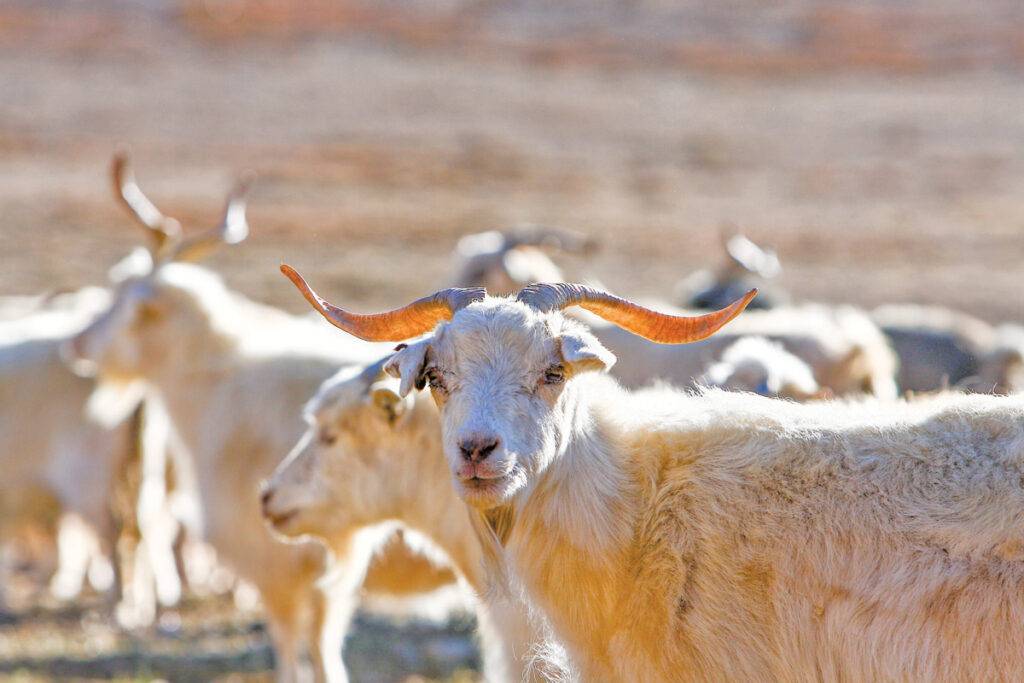Pashmina, or as Emperor Akbar used to call it, param naram, meaning very soft, is the finest variety of hand spun wool available in the world. Derived from the Farsi word Pashm, it means wool and has been a wardrobe essential for men and women of the upper strata since the sixteenth century. Harvested at the onset of summer in the hills of Kashmir, from the Tibetan goat called Changthangi or Pashmina goat; the wool when woven is super soft and feather light. Pashmina is Kashmir’s gift to the world as it is a beautiful, gossamer fine fabric. It has now developed as a huge, lively market, spanning across the continents.
The Pashmina was made popular by Emperor Akbar who wore the shawl as a shoulder mantle or a girdle. He was greatly impressed by its superlative fineness and warmth. His courtiers were frequently gifted Pashmina as a token of honour and also holy men for their spiritual accomplishments. Since then the demand for Kashmiri shawls spread to the west with the royal courts of England and France, where they became a symbol of power and wealth. The French were bewitched by the way they could drape the Pashmina and loved the glorious colours and designs that it adorned.
Early references to the shawl represent it as being a ‘doshala’ or a long fabric that was preferred by men to be draped on their shoulders for longer periods of time, while the square shape was favoured by women. The invisible sewing on the square shaped ’Rumal’, made it a much coveted item on every fashionista’s wish list.
Pashmina is indigenous to Kashmir and plays a major role in the state’s economy. Most of the manufacturing business is conducted in the capital city of Srinagar, where tourists throng to buy it. In its raw form, Pashmina wool is a mix of goat hair, dirt and dandruff and involves a long and tedious process of cleaning and combing the hair. Goat fleece is also collected from shrubs and rocks as it gets rubbed off the royal animals as summers approach. The raw fibre is manually picked and cleaned using damp rice flour to rid it of oil and impurities. It is then set on spinning platforms. It is noteworthy that weaving and spinning require extraordinary skill and females are the ones responsible for this stage of the process. The skill of fine spinning was passed down from mother to daughter, making it an inherited art. The spun, undyed fabric, called Alwan, is then ready to be woven into plain Pashmina. Kashmiris are expert craftsmen and pashmina trade has hugely profited due to local expertise to become the most famous textile of India. It is hand dyed and embroidered with exquisite designs. Besides being made into shawls, Pashmina is also popularly used for making cravats, caps and cloaks. In the sixteenth and seventeenth centuries, patterns were woven into the fabric though the craze for embroidered shawls started in the eighteenth century and was undertaken only by male artisans.
In Kashmir, weaving of Pashmina is done in the town of Gandharbal and around the Srinagar belt. Exquisite embroideries are undertaken by natives of towns namely Tailbal ,Buttpura, Narbal and Badgaon. They specialise in threadworks known as Suzani, Zilkar, Gulabdaar, Papier-mâché and Aabdar.
In northern India, where winters are bitingly cold, Pashmina has acquired the notoriety of being a status symbol. Shawls which are enhanced with fine Kashmiri embroidery are prohibitively priced and yet very desirable among the higher strata of our society. They are preserved and passed on as heirlooms. Nowadays, Pashminas which are embellished with buti designs, floral patterns and fringed with gold, silver or silk threads are highly in demand. The prices are determined by the quality of fabric and finesse of embroidery, as dense patterning requires longer hours and extra caution in handling. India has a thriving market for Pashmina with many designers now stepping in to cut out beautiful outfits from this finest of all fabrics.
The current trends show that the arrival of mechanisation in the Pashmina industry has led to the women being sidelined. Machines are now doing the difficult job of ‘dehairing’, which was earlier done only by women. Even ‘bobbin’ filling done by children, is now a mechanical activity. The aftermath of this great change has been loss of employment for both men and women. But since some political stability got restored, job opportunities were generated and daily wages have gone up, so have tourism and sale of Pashmina.
Mr.Kulbhushan Ahuja, M.D. of Ahujasons Shawls Private Limited in New Delhi shared with us the initiatives his company has taken for the empowerment of Kashmiri women. They have employed 6000 women in weaving and embroidering jobs. He says, “There is a growing respect among families for women working from home, since they are able to look after their home and hearth and also make contributions to the family income. As the women are provided with contract based jobs from a young age, they are increasingly gaining confidence and embracing new lifestyle.” These efforts are praiseworthy as women hardly get any recognition and respect in the male dominated society.
It is intriguing to know that a good quality Pashmina can set you back anything from Rupees 15000 to Rupees 5 lakh. A newly introduced Kalamkari shawl is woven in Kashmir, hand painted in Delhi and embroidered in Kolkata. A collector’s item, it is an eye popping product and costs Rupees 90 lakh.
Pashminas are timeless! They have surpassed the test of time and the fickleness of fashion. The allure remains undiminished and the reverence – undying. That is the magic of this ever priceless Pashmina!

